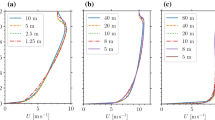Abstract
Functional forms of the universal similarity functions A, B (for wind components parallel and normal to the surface stress), and C (for potential temperature difference) are determined based on the generalized theory of the resistance laws for the Planetary Boundary Layer (PBL). The similarity-profile functions for the surface layer are matched with the velocity and temperature-defect profiles that are assumed to have shapes modified by certain powers of nondimensional height z/h, where h is the PBL height. The powers of the outer-layer profile functions are determined, so that the functions become negligible in the surface layer. To close the temperature defect law, an assumption that the temperature gradient across the top of the PBL is continuous with the stratification of the overlying atmosphere is used. The result of this assumption is that nondimensional momentum and temperature profiles in the PBL can be described in terms of four basic ratios: (1) roughness ratio η= ζ/h (2) scale-height ratio λ=|f|h/u*, (3) ambient stratification parameter κ=γh/θ*, and (4) stability parameter μ=h/L, where L is the Monin-Obukhov length, z0 is the surface roughness, γ is the upper-air stratification, u * is the friction velocity, and θ * is the temperature scale at the surface. For stable conditions, the scale-height ratio can be related to the atmospheric stability and the upperair stratification, and the generalized similarity and Rossby number similarity theories become identical. Under appropriate boundary conditions, function A is explicitly dependent on the stability parameter γ, while B is a function of scale-height ratio λ, which in turn depends on the stability. Function C is shown to be dependent on the stability and the upper-air stratification, due to the closure assumption used for the temperature profile.
The suggested functional forms are compared with other empirical approximations by several authors. The general framework used to determine the functional forms needs to be tested against good boundary-layer measurements.
Similar content being viewed by others
References
Arya, S. P. S.: 1977, ‘Suggested Revisions to Certain Boundary Layer Parameterization Schemes used in Atmospheric Circulation Models’, Mon. Wea. Rev. 105, 215–227.
Arya, S. P. S.: 1978, ‘Comparative Effects of Stability, Baroclinicity and Scale-Height Ratio on Drag Laws for the Atmospheric Boundary Layer’, J. Atmos. Sci. 35, 40–46.
Arya, S. P. S. and J. C. Wyngaard: 1975, ‘Effect of Baroclinicity on Wind Profiles and the Geostrophic Drag Law for the Convective Planetary Boundary Layer’, J. Atmos. Sci. 32, 767–778.
Blackadar, A. K.: 1962, ‘The Vertical Distribution of Wind and Turbulent Exchange in a Neutral Atmosphere’, J. Geophys. Res. 67, 3095–3102.
Brost, R. A. and Wyngaard, J. C.: 1978, ‘A Model Study of the Stably Stratified Planetary Boundary Layer’, J. Atmos. Sci. 35, 1424–1440.
Businger, J. A., Wyngaard, J. C., Izumi, Y., and Bradley, E. F.: 1971, ‘Flux Profile Relationships in the Atmospheric Surface Layer’, J. Atmos. Sci. 28, 181–189.
Deardorff, J. W.: 1972a, ‘Numerical Investigation of Neutral and Unstable Planetary Boundary Layers’, J. Atmos. Sci. 29, 91–115.
Deardorff, J. W.: 1972b, ‘Parameterization of the Planetary Boundary Layer in General Circulation Models’, Mon. Wea. Rev. 100, 93–106.
Derbyshire, S. H.: 1990, ‘Nieuwstadt's Stable Boundary Layer Revisited’, Q.J.R. Meteorol. Soc. 116, 127–158.
Hess, G. D.: 1973, ‘On Rossby-Number Similarity Theory for a Baroclinic Boundary Layer’, J. Atmos. Sci. 30, 1722–1723.
Högström, U.: 1988, ‘Non-Dimensional Wind and Temperature Profiles in the Atmospheric Surface Layer: A Re-evaluation’, Boundary-Layer Meteorol. 42, 55–78.
Kazanski, A. B. and Monin, A. S.: 1960, ‘A Turbulent Regime above the Ground Atmospheric Layer’, Izv. Akad. Sci. USSR Geophys. Ser. 1, 110–112.
Kitaigorodskii, S. A. and Joffre, S. M.: 1988, ‘In Search of a Simple Scaling for the Height of the Stratified Atmospheric Boundary Layer’, Tellus 40A, 419–433.
Long, R. R. and Guffey, L. J.: 1977, ‘Drag and Heat Transfer Relations for the Planetary Boundary Layer’, Boundary-Layer Meteorol. 11, 363–374.
Monin, A. S. and Yaglom, A. M.: 1971, ‘Statistical Fluid Mechanics; Mechanics of Turbulence’, Vol. 1, The MIT Press, Cambridge, Mass., 769 pp.
Nieuwstadt, F. T. M.: 1985, ‘A Model for the Stationary, Stable Boundary Layer’, in J. C. R. Hunt (ed.), Proc. IMA Conf. Turbulence and Diffusion in Stable Environments, Oxford Univ. Press, Cambridge 1983, pp. 149–179.
Sedefian, L.: 1980, ‘On the Vertical Extrapolation of Mean Wind Power Density’, J. Appl. Meteorol. 19, 488–493.
Swinbank, W. C.: 1964, ‘The Exponential Wind Profile’, Q.J.R. Meteorol. Soc. 90, 119–135.
Tennekes, H.: 1982, ‘Similarity Relations, Scaling Laws and Spectral Dynamics’, A chapter in F. T. M. Nieuwstadt and H. Von Dop (eds.), Atmospheric Turbulence and Air Pollution Modelling, D. Reidel, Boston, pp. 37–68.
Vachat, R. D. and Musson-Genon, L.: 1982, ‘Rossby Similarity and Turbulent Formulations’, Boundary-Layer Meteorol. 23, 47–68.
Yamada, T.: 1976, ‘On the Similarity Functions A, B, and C of the Planetary Boundary Layer’, J. Atmos. Sci. 33, 781–793.
Zilitinkevich, S. S.: 1975, ‘Resistance Laws and Prediction Equations for the Depth of the Planetary Boundary Layer’, J. Atmos. Sci. 32, 741–752.
Zilitinkevich, S. S.: 1989, ‘Velocity Profiles, the Resistance Law and the Dissipation Rate of Mean Flow Kinetic Energy in a Neutrally and Stably Stratified Planetary Boundary Layer’, Boundary-Layer Meteorol. 46, 367–387.
Author information
Authors and Affiliations
Rights and permissions
About this article
Cite this article
Byun, D.W. Determination of similarity functions of the resistance laws for the planetary boundary layer using surface-layer similarity functions. Boundary-Layer Meteorol 57, 17–48 (1991). https://doi.org/10.1007/BF00119712
Accepted:
Issue Date:
DOI: https://doi.org/10.1007/BF00119712




